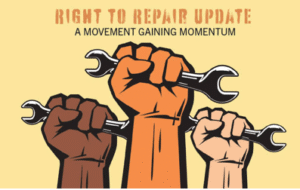
Why in News
-
India accepted a proposal to introduce a Repairability Index for electronics, marking a step towards making the Right to Repair a consumer right
-
Experts caution that India’s informal repair economy, based on tacit and generational knowledge, is being overlooked in digital and AI policy frameworks
About Right to Repair in India
Definition
-
The Right to Repair refers to the legal right of consumers to:
-
Repair and modify their products
-
Access affordable third-party repair services
-
Global Trend
-
The European Union mandates:
-
Access to spare parts
-
Availability of repair manuals for consumers
-
-
Several states in the US and the UN Sustainable Development Goal 12:
-
Support repair-based sustainability practices
-
Indian Framework
-
The Department of Consumer Affairs launched a Right to Repair Portal in 2023
-
Covers sectors like electronics, automobiles, and agricultural tools
-
Why Repair Must Be More Than a Consumer Right
Tacit Knowledge Economy
-
Informal repairers gain skills through:
-
Observation
-
Mentorship
-
Hands-on experience
-
-
Not dependent on formal certifications
-
Examples:
-
Karol Bagh in Delhi
-
Ritchie Street in Chennai
-
Sustainability through Resourcefulness (Jugaad)
-
Repair culture:
-
Extends product lifespan
-
Reduces electronic waste
-
Reflects India’s culture of frugality and innovation
-
Unorganised but Essential Workforce
-
Informal repairers:
-
Are left out of formal labour policies
-
Still play a key role in India’s circular economy
-
Cultural Identity of Repair
-
Local repair practices:
-
Showcase India’s indigenous tech heritage
-
Feature region-specific innovations
-
Loss of Repair Literacy
-
Increasing use of:
-
Disposable goods
-
Sealed product designs
-
-
Threatens:
-
Traditional repair knowledge
-
Reuse culture
-
Gaps in Digital and Policy Frameworks
Electronic Waste (Management) Rules 2022
-
Focus is mostly on recycling
-
Does not promote repair as the first step to tackle electronic waste
Pradhan Mantri Kaushal Vikas Yojana (PMKVY)
-
Training programs are:
-
Rigid in structure
-
Unsuitable for the flexible, diagnostic nature of repair work
-
Artificial Intelligence and Digital Public Infrastructure
-
Current policies:
-
Focus on structured data systems
-
Ignore informal, human-led repair knowledge
-
National Education Policy 2020
-
Promotes experiential learning
-
But does not recognize repair skills as part of vocational education
Lack of Legal Support for Repairers
-
Informal repairers:
-
Have no legal rights
-
Lack certification pathways
-
Are unrecognized in the digital economy
-
Steps for an Inclusive and Sustainable Repair Ecosystem
AI and Digital Public Infrastructure Standards
-
Integrate repairability norms into:
-
AI tools
-
Hardware standards
-
Public procurement policies
-
Expanded Right to Repair Framework
-
Classify products based on repairability
-
Ensure:
-
Access to parts
-
Availability of repair manuals
-
Support for community-based repair hubs
-
Recognition and Skill Development
-
Use platforms like e-Shram to:
-
Recognize informal repairers
-
Reskill them with customized training modules
-
Knowledge Preservation
-
Use AI models and decision trees to:
-
Digitize tacit repair knowledge
-
Make insights widely accessible
-
Policy Convergence
-
Coordinate efforts of:
-
Ministry of Labour and Employment
-
Ministry of Electronics and IT
-
Ministry of Rural Development
-
-
Build a unified policy framework that values repair as labour and knowledge
Significance for India’s Development
Sustainability and SDGs
-
Supports:
-
Sustainable Development Goal 12
-
Mission Lifestyle for Environment
-
-
Helps:
-
Extend product lifespan
-
Reduce waste
-
Labour Empowerment
-
Acknowledges:
-
Informal repairers as skilled workers
-
Their role in economic and tech resilience
-
Digital Justice
-
Ensures that:
-
AI and digital growth includes human-led repair knowledge
-
Economic Inclusion
-
Bridges:
-
India’s digital vision and grassroots innovations
-
Improves livelihood security
-
Leadership in Circular Economy
-
Positions India as:
-
A global leader in sustainability by embedding repair into the economy
-
Conclusion
-
Repair should be recognized as both a right and a responsibility in India’s digital shift
-
Policies must include tacit knowledge from informal repair workers for inclusivity and sustainability
-
As Michael Polanyi said, “We know more than we can tell.”
-
India must preserve and value its repair wisdom before it disappears




